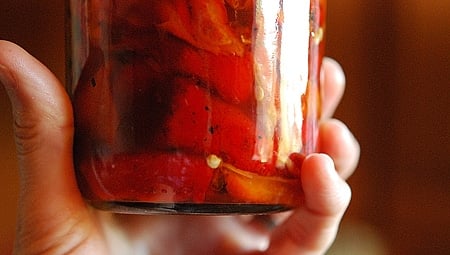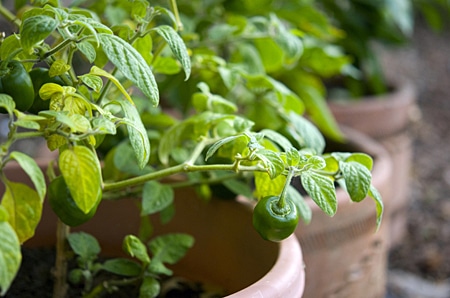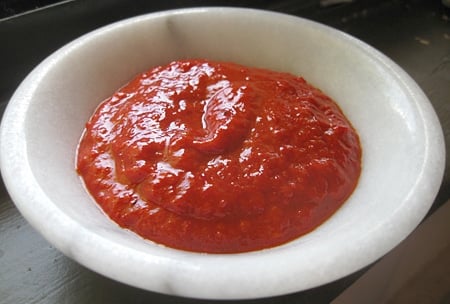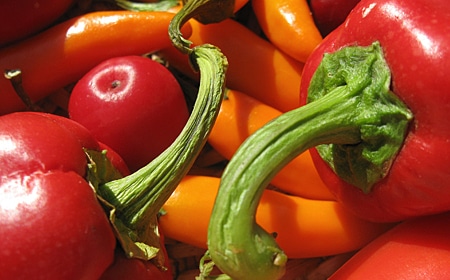As an Amazon Associate I earn from qualifying purchases.

Consider, for a moment, the sweet pepper. No other plant demands so much, gives so little, yet keeps us coming back for more.
Sweet peppers are the coquettes of my garden. I coddle them, dote on their every need, and in return they toss me a few fruits to play with — so few, in fact, that I can barely bring myself to eat them fresh. I preserve almost every one the little minxes give me to eat huddled, alone, in the dead of winter. Or something like that.
Every year I say, “I need to plant more sweet peppers.” Every year I plant a few more. It’s never enough. I could lay waste to everything else in my garden and plant only an array of red bells, piquillos, padrons, pimientos and sweet cherry bombs — and still it would not be enough. It is not possible to have too many sweet peppers; chiles yes, but not sweet peppers.
What’s more, after these princesses deign to drop me a pepper or three, it has become so late in the season that they die soon afterward, our relationship barely consummated. It reminds me of some character in an Edith Wharton novel (and yes, I’ve read several. Blame my mother for that one…)
Disconsolate, I used to count the days until February, when I could start a new set of seeds under hot lights inside; even in birth, sweet peppers need to be the center of attention.
But then, one day, I found a way to cheat death.Yes, it is as simple as a heavy pot, a warm climate, and a quirk of biology.

I live in Northern California, and in my little spot of land, we get a hard frost only once every few years. Light frosts, which are enough to kill a pepper, come no more than a couple dozen times a year in my garden. But in the front of my house, which faces south, those light frosts come less than a dozen times a year, and even in the dead of winter the highs soar past 50 degrees — warm enough to keep a pepper alive.
But aren’t peppers annuals? No. And that is a dirty secret perpetrated by seed dealers everywhere. The coquettes aren’t eager to die after all, it seems. Only cold kills them. What they want is an even deeper commitment from you the gardener before they willingly give up their fruit. I once had a Thai chile — a capiscum frutescens, for you pepper freaks out there — that lived five years. My rocoto peppers are two years old and going strong. Peppers, like most of us, want a long-term relationship.
So I dig up my peppers from the garden every October, pot them up and move them to the front yard, which is such a blast furnace in summer — routinely reaching 110 degrees — that it would burn most peppers; that’s why I don’t keep them in the front all year long.It works for me. And it would work for anyone who has a sunny window. My Thai chile lasted in Minnesota until one day even the inner windowsill dropped below 30 degrees. (Outside it was -19 degrees, -30 with the wind.) So it can be done.
Once spring returns, you will find your peppers strong and ready to flower early and grow large. And mature peppers bear more fruit.
What to do with that fruit? Well, I’d venture to guess that everyone reading this has a favorite pepper recipe. I have lots on this site. But I also preserve a lot of peppers, less out of fear now than because preserved peppers take on a character totally unlike fresh ones.
My main method is to roast the peppers over an open fire, then preserve them with a little salt, vinegar and oil. Peppers lack natural acid, so need to be pressure-canned if you aren’t using vinegar or salt. I don’t do much pressure-canning, so I use a hybrid pickle method that works well for me.

This way of preserving does a number of things. Roasting kills any enzymes in the peppers that might deteriorate them over time, as well as softening and sweetening the peppers — not to mention getting rid of the indigestible skins. I then dredge the peppers in vinegar to up the acid level and give the peppers more tang. After that I salt them liberally to make things even more stable; salt also adds to the flavor. And finally I cover everything in olive oil to keep air out. Some tips:
- Dry the peppers after washing them, and oil them lightly before grilling or roasting under the broiler.
- Grill them hard, as in blackened. Very few peppers have the thick skin a pimiento does (pimientos are bred to be roasted and peeled, so they have unusually thick skins), and a thin skin can be a bear to peel off unless it is good and charred.
- Steam the roasted peppers for a long time, in a paper bag. Don’t use plastic, as it will often melt. And you can wait on this step for up to an hour or so. Nothing quite so fun as to be scalded with nuclear-hot pepper juice when you’re trying to peel them.
- Don’t wash the peppers once peeled. You want all that pepper juice you can collect, and running the peppers under water will rob you of that. This is the secret to really, really good roasted peppers.
Another preserved pepper preparation (say that one five times fast!) I often do is make sauces. One of my favorites is a variant on a Hungarian sauce I once bought solely for the color: shocking, neon red. A classic “shiny things!” moment. Basically this sauce is made from roasted gypsy peppers, which are both hot and sweet at the same time, pureed with white wine vinegar, salt and a little olive oil.

Again, the vinegar, salt and oil are what preserves this sauce, which I have kept in the fridge for a year. The only pain is peeling gypsy peppers, which are both thin-skinned and thin-walled, unlike the thick-walled bell peppers we’re used to. A small price to pay.
I use this coulis, which is what the French would call it, as an ingredient in other sauces — particularly a Spanish, pepper-based dish called chilindron — as well as with fish or pheasant. You could use chicken. I find it marries better with light meats, not red meat like venison or beef.
For most of you it is not too late to rescue your peppers. Those of you in colder climates may be forced to choose which pepper’s charms most attract you, as you may not have space to save everyone. And don’t be worried about the pepper dropping leaves in winter; it happens. Just keep it in a sunny spot, protect it from whiteflies, and keep it as warm as you can. It will repay you for your kindnesses next year.

_________________
[recipe_name]PRESERVED ROASTED RED PEPPERS[/recipe_name]
[summary]There are a lot of ways to preserve red peppers. You can pickle them, which is nice, but a little limiting; pickled sweet peppers are good for an appetizer, but little else. Once you roast the peppers, however, things change.
Roasted peppers are a delight. I use them as appetizers like the pickled peppers, but also in sauces, stews and simply draped over roasted or grilled meat. Roasting — especially over an open flame — sweetens and softens the pepper, and more importantly, allows you to be rid of the indigestible skin.
Yes, you can pickle the roasted red peppers, too, but I’ve developed a method inspired by an obscure English book by Nora Carey called Perfect Preserves. Carey uses a hybrid pickling, sott’olio method to keep her peppers delicious through her British winters. I’ve adapted it a little to reflect the hotter California climate.[/summary]
[yield]Makes about 2 pints.[/yield]
Prep Time:[preptime time=35M] 35 minutes[/preptime]
Cook Time:[cooktime time=45M] 45 minutes[/cooktime]
- [ingredient] [amount]8[/amount] [item]red peppers[/item], or really any colored peppers [/ingredient]
- [ingredient] [amount]2 tablespoons[/amount] [item]olive oil[/item] [/ingredient]
- [ingredient] [amount]1 cup[/amount] [item]vinegar[/item] (any kind) [/ingredient]
- Kosher salt
- Canning jars
- A chopstick or butter knife
[instructions]
- First wash, dry and then lightly oil your sweet peppers. You can do this with hot peppers, too, but be sure to use thick-walled varieties such as jalapenos.
- Roast your peppers. Ideally this is over a smoky wood fire, on a grill. Second choice is a gas grill, third an open burner on a stove. Alternatively, arrange your peppers on a broiling pan and broil them. No matter what your heating method, you will need to turn your peppers from time to time as the skins char and blacken.
- When the peppers are mostly blackened, remove them to a paper grocery bag and roll up the bag to seal in the steam. You want to steam the peppers in their own juices. Let the bag sit for 20-40 minutes.
- After the peppers have cooled and steamed, take them out one at a time and remove the skins, stems and seeds. Have a little water running in the sink so you can wash your hands off periodically. Do NOT run the peppers under the water, as this robs them of flavor. Once each pepper is cleaned — get as many seeds out as you can — drop it in a bowl. Do all the peppers before proceeding.
- Once all the peppers are cleaned and in the bowl, get a shallow bowl or small casserole pan and pour in some vinegar. I use red wine, cider or sherry vinegar for red peppers (sherry when I want them to be Spanish, cider for Portuguese, red wine for Italian or Greek) and white wine for green peppers.
- Dredge each pepper through the vinegar a few times to get it good and coated. Place it in another bowl. Do this for all the peppers.
- Sprinkle the bowl with all the peppers with kosher salt. Gently mix the peppers together like a salad. Sprinkle a little more salt and repeat. Sprinkle a little salt into the bowl with the pepper juice — the original bowl.
- Gather canning jars and pour a little vinegar into each one; enough to cover the bottom of the jar. Pack in the peppers, leaving about 1/2 space at the top. Use a butter knife or chopstick to run down the sides of the jars, releasing air bubbles. You will notice the level of liquid drop. Fill it with the salted pepper juice — but still leave room at the top of the jar.
- Once the air is out to the best of your ability and the vinegar-pepper juice it right at the top of the level of the peppers, pour in olive oil on top of everything to a depth of 1/4 inch. Screw the lids on the jars and you’re done. No sealing needed. These peppers will last a year in the refrigerator, although they will soften over time.
[/instructions]




Ray: Yep, you can. I’d process for maybe 10 minutes or so.
Can I use your canning method and still put the canning jars in boiling water to seal them?
Beautiful pictures and I love your writing! We are working on our own website focusing on fresh, homegrown or local veggies.. I’m going to put up a recipe for what I’m doing with my roasted red peppers, I’d love to link it to this article so they can see how to make their own peppers! I can’t wait until my own peppers grow (green, red, and black) so I can preserve them for those cold winter months too
Thank you for the tips for preserving the red peppers. I have never put them in jars but will now. I’m from Tsawwassen and although cannot grow good peppers I will wait for the peppers to come on sale and then roast them in my Bar B Q….. beautiful red bell peppers, pablanos etc. If I’m doing hamburgers, I put the peppers on the top grill to cook first and then will do the charring. I then put the charred peppers in a metal bowl and cover them tightly with plastic wrap, leaving them to sweat for a good 45 minutes to cool. I then peel them, take out all the seeds and put them in zip lock bags…….I divide the natural pepper juice into each bag and press all the air out before I seal them. I then freeze them. When I need the peppers, they are as fresh as the day I put them into the freezer. They will keep for several years. When you need the roasted peppers, thaw them and drain them. Do not wash the peppers in water. Add a bit of salt and olive oil and enjoy… Dominic
Thanks for the great info.
In ‘Down Under’ Sydney, I’ve left capsicum plants in the ground facing west over winter. They have survived a few frosts (near zero degrees not usually below zero), lost a few leaves and bounced back ‘as good as gold’ in the Spring, I’ve also tried pickling them and they were a huge success last year.
Enjoy your day, whatever you do, wherever you do!!
Evelyn: You want them well-salted, which helps the preservation. I sprinkle salt over each pepper on both sides until they look a little more salty than a normal person would want to eat on the spot. Sorry, but I do not measure exactly.
Your roasted red bell pepper recipe says “sprinkle a little salt” on the peeled roasted peppers. How much is a little??
You must make muhammara with those fresh peppers. My favorite middle eastern dish, and all-around condiment/dip. sahtein.
https://jugalbandi.info/wp-content/uploads/2008/12/img_4175copy.jpg
I brought in two of my pepper plants this year. I’m hoping they survive the low light conditions we have here during winter in Canada. I guess we’ll see.
I don’t have a garden, but I still preserve peppers every autumn. After preserving bushels of ’em every year with my dad when I was a kid, it’s sort of in my blood.
sounds great, and now I’m wishing we still had peppers in the farmer’s market. Maybe I’ll try starting some now for next spring… we’re awfully mild winters down here, could work. Last years we had such an overabundance of jalapenos that I actually sold some at the local co-op, and this from two plants that had survived the winter and produced a second year. This year our garden was a spectacular FAIL.
Sarah: Nope. I don’t bother with greenhouses, although I prolly should, more for light purposes than warmth.
Wino: Will be interesting to see just how long those habaneros will survive. Four years is a long time…
Sylvie: Great idea! Again, though, I’d need to build that greenhouse.
oooo. How I wish I hadn’t pulled those spindly plants that survived being planted too close to the squahes. UGH! Next year! Next year!
with about 2 dozen pepper plants (yes, I agree you can’t have too many), digging them up takes too much room. However… starting a new batch of seeds in late summer and overwintering the seedling in the greenhouse… now, that works better for me!
Thanks for the roasted sauce idea… I do that with hot pepper… I never thought of doing it with sweet peppers.
I live in San Martin.
I dig up 3 large habanero chili plants and put them in my green house each fall.
They keep the fruit for a while, and eventually the leaves fall off and the chilies start getting moldy unless you pick and process them.
My plants go back in the garden in the spring.
My 3 plants are about 4 years old now.
I do still have peppers in the ground, you mindreader. Have you experimented at all with greenhouse-type contraptions?
I think I’m going to try to construct one this year for the peppers using PVC and heavy clear plastic or something. We’ll see. If you have any tips, do let me know.
Jimmy Nardello’s, probably my favorite pepper. I’m going to try out that light coating of oil before roasting next year. Thanks.
On etime my mom gave me a Nicholas Sparks novel … for Christmas … and I read it.
Gaaaaa! I am sooooo jealous! That your climate allows you to grow these beauties year ’round, that you have so many varieties planted, ack! Must…plant…more…next…year…
OK, now that I’ve got that out of my system, I’ve become addicted to Jimmy Nardello’s, a sweet Italian heirloom with a great back story that is sold by Seed Saver’s Exchange. Also must have at least a couple of anchos every year. Spanish pimientos de padron are on my wish list, but it’s hard to find the proper (small, not hot) variety.
Thanks for the preserving hints!
wow, I have just learnt a lot about peppers. Heck, I might even try to grow them next year – but up here in Seattle they certainly wont last through the winter – even more reason to preserve them.
There is also nothing more satisfying (OK, that might be a bit of a lie) than peeling the skin in one piece of a pepper. Hardly ever happens for me though. Maybe I don’t steam them long enough.